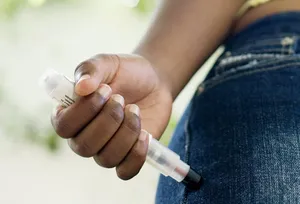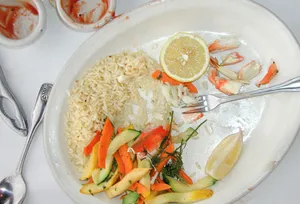The start of food allergies in adulthood is not common and is
surprising given the prevalence of allergies emerging in
childhood. A large survey (Food Allergy and Education FARE) of
40,0000. adults in 2015-2016 found that 1 out of 10 adults has a
food allergy. Half of these allergies began in adulthood. The
most common adult onset food allergy was shellfish, followed
by milk and peanut making the top three allergies. The survey
provides excellent adult allergy information. Further research
will be needed to understand the cause of adult onset allergies.

Adult-Onset Food Allergies Increasing, Confusing

FROM THE WEBMD ARCHIVES
Jan. 14, 2019 — Martin Malawer, MD, had environmental allergies as a child but never had any reaction to food until he was about 30,000 feet in the air on a plane to France.
“About two-thirds of the way over the Atlantic, I had shrimp cocktail in business class. I had that a million times with no problem, but all of a sudden one eye started swelling up,” he says. “About half an hour later, my other eye started swelling up. It got very bad. I could hardly see out of them, and then I started getting short of breath,” Malawer, an oncology surgeon, recalls of that flight more than 30 years ago.SLIDESHOW
Slideshow: Food Allergy Triggers, Common and Uncommon





















Reviewed by Melinda Ratini on 2/18/2020
With his medical training, he immediately knew he was having an allergic reaction, but the flight crew didn’t have any epinephrine in their first aid kit. So the flight attendants gave him antihistamines.
“By the time we landed in Paris, I couldn’t see out of my eyes, they were so swollen,” says Malawer, who got treatment and recovered once he was on the ground. When he returned home to the United States, he went to an allergist and discovered he had gotten an allergy to shrimp at the age of 40. More than 30 years later, he still has it, something he knows because he’s accidentally come in contact with shrimp a few times through the years.
“One day when I was working at the hospital, I ate some soup and didn’t realize there was shrimp in it. The same reaction started happening again, so a nurse ran and got epinephrine and gave it to me, and it stopped,” he explains.
Malawer is part of the more than 10% of adults in the United States — more than 26 million — now estimated to have a food allergy, according to a new study published this month in JAMA Network Open. Ruchi Gupta, MD, a pediatrician at Lurie Children’s Hospital in Chicago, led the team.
“We think of food allergies happening in children, and they do, at a rate of about 1 in 13. But I don’t think the U.S. has really talked about how often this happens in adults. Adult food allergies impact one in 10, and half of these are food allergies starting in adulthood,” says Gupta, who’s also a professor of pediatrics at Northwestern University’s Feinberg School of Medicine.
Allergy Statistics
There are a lot of data about food allergies in children, but until now, there hasn’t been much research done on how often food allergies appear after someone is an adult.
“Prevalence studies such as this one are much needed to help us further define the scope of the food allergy epidemic in the U.S.,” says Lisa Gable, CEO of Food Allergy Research & Education (FARE), the largest nonprofit dedicated to food allergy awareness, education, and research .
The new data come from a 2015-2016 survey of more than 40,000 adults across the country, and Gupta says it is one of the first to assess the general population for specific food allergy types and symptoms. The results show:
- One in 10 adults have a food allergy.
- More than half (51.1%) have had a severe reaction.
- Almost four in 10 (38.3%) report at least one reaction that required emergency care.
- But only one in 20 with a convincing food allergy have a doctor-confirmed diagnosis.
- And less than a quarter (24%) with a food allergy report a current epinephrine prescription.
Given the rise of allergies in children, Gupta says, it makes sense that more adults have allergies, because those children are growing up. But she says that doesn’t entirely account for the prevalence of food allergies among adults. Her research finds:
- 48% of the adult population with a convincing food allergy reported getting at least one as an adult. (They may have had others as a child.)
- But one out of 4 adults with a food allergy reported getting their first allergy in adulthood.
“This study signals that food allergy among adults is a more significant issue in the U.S. than previously thought, particularly the emerging health problem of adults developing their food allergies later in life, even after regularly eating foods that were previously harmless,” Gable says.
“We were surprised that adult-onset food allergies were so common,” Gupta says. “More research is needed to understand why this is occurring and how we might prevent it.”
Researchers also discovered that nearly one in five, or 19%, of adults think they have a food allergy, but researchers say the symptoms they reported may actually be consistent with other food-related conditions. Gupta says negative reactions to food are common and can be confusing, with some being treatable and others life-threatening. Possible causes outside of a true food allergy may include intolerances, sensitivities, oral allergy syndrome, and many others.
What Adult Reactions Look Like
When it comes to types of food allergies, Gupta’s study finds shellfish is the top food allergen in adults, affecting 7.2 million of them.
Food Allergies and Food Intolerance
WebMD provides an overview of food allergies and intolerances, their symptoms, causes, diagnosis and treatments.ABOUT
“Shellfish allergy commonly begins in adulthood, is rarely outgrown, and therefore impacts the lifespan,” she explains.
Jodi Duke has experienced that. She got an allergy to shellfish in her 30s after having her second child. Until then, she ate crab often and loved it. But during her last visit to a crab house, she took a bite and suddenly realized something had changed.
“I began to feel hot and dizzy. The next thing I remember was waking up on the floor. I had passed out and ended up in an ambulance headed to the emergency room. After several tests, the doctors explained that everything looked good on the tests and I should consult an allergy specialist,” Duke explains. “When I did, I found out I had developed a shellfish allergy and am now unable to eat any type of shellfish. I am lucky that my allergy is the type that I have to actually eat the shellfish to have a reaction, but I do still have to be careful.”
Gupta’s study found rates of all allergies, no matter when they started, were high in adults for a variety of other foods too, including:
- Milk (4.7 million people)
- Peanut (4.5 million people)
- Tree nut (3 million people)
- Fin fish (2.2 million people)
- Egg (2 million people)
- Wheat (2 million people)
- Soy (1.5 million people)
- Sesame (0.5 million people).
As for causes, little is known for sure, but Gupta says her team is looking at data to explore that. She says they are focusing on hormone changes, like pregnancy, as well as genetic and environmental triggers, like a change in location or possible viral and bacterial causes.
“Understanding potential triggers for new allergies is essential as we are seeing more adult-onset food allergy, and significantly more in women than men. We need to examine the why,” Gupta says.
Managing Food Allergies
FARE, the allergy nonprofit, says a food allergy reaction sends someone to an emergency room in the United States every 3 minutes. The group warns that symptoms can appear within minutes or hours after eating a food, and reactions can affect skin (hives), the gastrointestinal tract (vomiting or diarrhea), or your respiratory or cardiovascular system. Reactions are also very unpredictable. They can vary between people, from mild to severe and anaphylactic (a reaction that could be life-threatening), and the same person may not react the same twice.
Allergy experts say the potential severity of reactions, paired with the rise in allergies, points to the need for clear information on ingredients, so many hope those in the food industry are paying attention to this new data.
“If one in 10 people who enter your restaurant could exit in an ambulance if you make a mistake, you better not ignore what people are telling you,” says Scott H. Sicherer, MD, director of the Jaffe Food Allergy Institute at the Icahn School of Medicine at Mount Sinai in New York City. “These numbers mean industries have to be careful with labeling. Restaurants have to be careful with serving, and physicians need to make sure to educate adults who might not watch out for themselves as much as their children. This is not something to minimize. It’s the opposite. A lot of people have significant allergies, and we have to take this seriously.”
Allergy experts say the other message that people should take from this study is to see a doctor if you have a reaction to food. Many, like Erin Malawer, the author of the food allergy awareness blog Allergy Shmallergy, are concerned how many appear to be trying to handle food reactions without proper guidance or emergency medicine.
“Patients with food allergies, both children and adults, uniquely rely on others to keep them safe. This means they need other people to have a general level of understanding about food allergies. It appears that even those suffering symptoms don’t have the information they need to manage their own condition properly,” she explains.
Doctors and advocates agree that a proper diagnosis is critical.
“It is important to get a diagnosis so you know how to manage it daily,” Gupta says.
“Self-diagnosis can limit your diet unnecessarily and may prevent you from receiving appropriate care, including epinephrine auto-injectors that can save your life in the event of a severe food allergy reaction,” Gable says.
Katie James can speak to the fact that a proper diagnosis can be life-changing. She says she thought she had food allergies because in her mid-20s, she had nausea, bloating, gas, stomach cramps, and diarrhea after meals. “It wasn’t consistent enough to pinpoint the culprit, but I was convinced I had to be allergic to something. My symptoms were severe, and I would feel sick for about 24 hours,” she says.
She went to an allergist for testing, which showed she had no food allergies, so the allergist suggested she document everything she ate for a week to see if patterns emerged. They quickly did.
“I kept my journal for about a week, and then my diagnosis became obvious: I was lactose intolerant. My doctor recommended lactase pills, and sure enough, I was able to ingest milk, ice cream, decadent cream pasta, and of course, pizza,” James says. “It was such a simple ‘cure’ to such a debilitating problem.”WebMD Health News Reviewed by Brunilda Nazario, MD on January 11, 2019


Leave A Comment